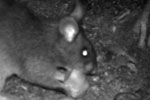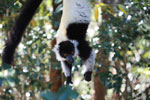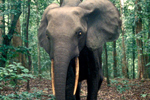
An agouti in Panama. Photo by: Rhett A. Butler.
In order to disperse their seeds, large-fruited tropical trees probably relied on massive mammals that roamed the earth over 10,000 years ago. But with giants such as the mastodon now extinct, thieving rodents—who continually excavate and rebury others’ seeds—may be filling their role, according to a new study in the Proceedings of the National Academy of Sciences (PNAS).
Historically, tropical trees such as the black palm (Astrocaryum standleyanum) relied on large fauna to eat their oversized fruits and spread the large seeds within. With major mammals now absent from new world landscapes, “the question is how this tree managed to survive for 10,000 years if its seed dispersers are extinct,” said study co-author Roland Kays in a press release.
The answer may lie in the thievish activity of small scatter-hoarding rodents. The agouti, a common rodent found in Central and South America, has long been known to bury seeds, but what surprised the researchers was “this constant digging up of the seed, moving it and burying it, over and over again,” Kays stated.
The long-distance spread of the seeds was driven by an unusual behavior: retaliation. Individuals whose seeds had been robbed tended to steal seeds from others, and this helped spread the seeds beyond the range of a single Agouti. According to the study, “the stepwise dispersal of seeds across home range boundaries was driven by [this] reciprocal theft.”
To capture the thefts, the researchers relied on a combination of video surveillance cameras and radio transmitters to track and tag both seeds and Agouti. This approach led them to find that just 16 percent of dug up seeds were recovered by their owner. Furthermore, instead of being eaten, 88 percent of the excavated seeds were moved to a new site and reburied. This movement helped disperse the seeds up to 280 meters from their starting point.
Beyond helping prevent certain tree species from becoming extinct today, the robbing rodents may also play a beneficial role in the future.
“When you think about global climate change and habitats shifting, for a forest to move into new areas, trees need to have their seeds move into new areas,” Kays elaborates in the press release. Even in the absence of large mammals, thieving rodents may continue to provide a pathway for that to happen.
CITATION: Jansen, Patrick A., Ben T. Hirsch, Willem-Jan Emsens, Veronica Zamora-Gutierrez, Martin Wikelski, and Roland Kays. 2012. “Thieving Rodents as Substitute Dispersers of Megafaunal Seeds.” Proceedings of the National Academy of Sciences (July 16). doi:10.1073/pnas.1205184109.
Tyler Lark is an Environment & Resources graduate student researching agricultural land use change at the Center for Sustainability and the Global Environment (SAGE) at the University of Wisconsin-Madison.
Related articles
Struggling to conserve seed biodiversity: the gaps and wisdom in current research
(07/18/2012) Biodiversity conservation is huge field, but at its heart we find something very small: the seed. From seeds come the plants we need and food for the animals we hope to conserve as well. Knowledge of seed dispersal, or how seeds are generated and move through the landscape, is essential if we are to understand the influence of human activity on biodiversity.
Giant rat plays big ecological role in dispersing seeds

(11/16/2011) Rats are rarely thought of as heroes. In fact, in many parts of the world they are despised, while in others they serve largely as food. But, scientists are now discovering that many tropical forest rodents, including rats, serve as heroic seed dispersers, i.e. eating fruits and nuts, and carrying seeds far from the parent tree, giving a chance to a new sapling. While this has been documented with tropical rodents in South America like agoutis and acouchis, a new study in Biotropica documents the first successful seed dispersal by an African rodent: the Kivu giant pouched rat (Cricetomys kivuensis), one of four species of giant African rats.
Critically Endangered lemurs disperse seeds, store carbon

(11/13/2011) Many tropical plants depend on other species to carry their progeny far-and-wide. Scientists are just beginning to unravel this phenomenon, known as seed dispersal, which is instrumental in supporting the diversity and richness of tropical forests. Researchers have identified a number of animal seed dispersers including birds, rodents, monkeys, elephants, and even fish. Now a new study in the Journal of Tropical Ecology adds another seed disperser to that list: the Critically Endangered black-and-white ruffed lemur (Varecia variegata). Capable of dispersing big tree species, the black-and-white ruffed lemur may even play a big role in carbon sequestration.

(08/01/2011) Among conservationists and biologists, the mega-island of Borneo is a sort of Mecca. Its rich plant and animal biodiversity, as well as high degree of endemism (unique species found nowhere else) make it a naturalist’s dream. There is one aspect of this biological richness which applies to the wellbeing and happiness of all of Borneo’s residents, human and animal, in a very direct way: fruit. From wild forest berries to juicy cultivated rambutans, fruit permeates the ecology, landscape and culture of Borneo. On the island there are over 70 wild fruit trees species and around 45 cultivated species that are consumed by people (1). Science has certainly not yet documented all the fruit consumed by wildlife, but we know that the total must be over 500 species.
Elephants: the gardeners of Asia’s and Africa’s forests

(04/25/2011) It seems difficult to imagine elephants delicately tending a garden, but these pachyderms may well be the world’s weightiest horticulturalist. Elephants both in Asia and Africa eat abundant amounts of fruit when available; seeds pass through their guts, and after expelled—sometimes tens of miles down the trail—sprouts a new plant if conditions are right. This process is known by ecologists as ‘seed dispersal’, and scientists have long studied the ‘gardening’ capacities of monkeys, birds, bats, and rodents. Recently, however, researchers have begun to document the seed dispersal capacity of the world’s largest land animal, the elephant, proving that this species may be among the world’s most important tropical gardeners.